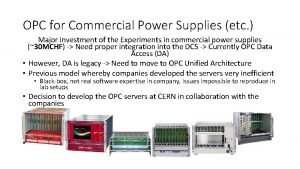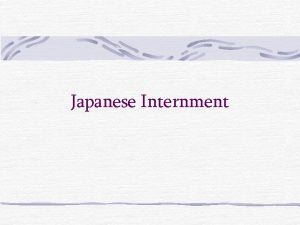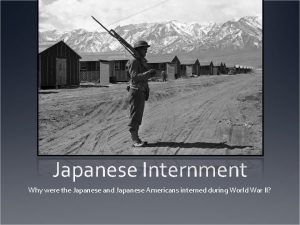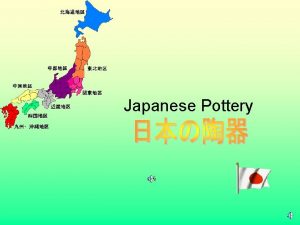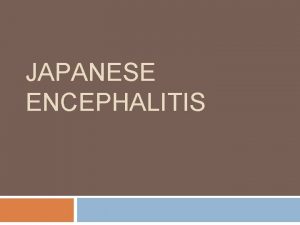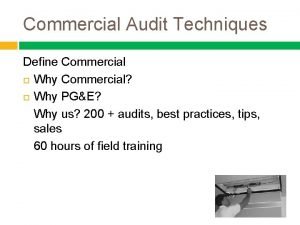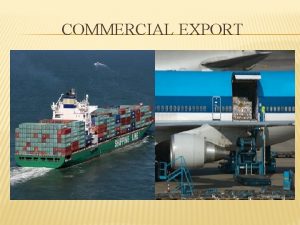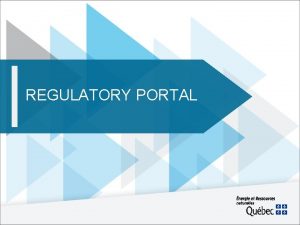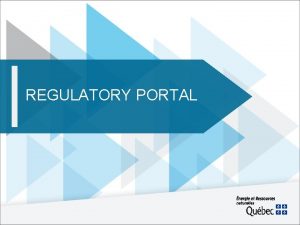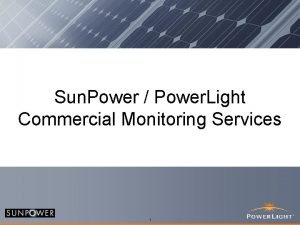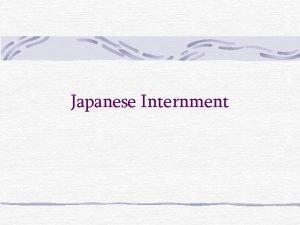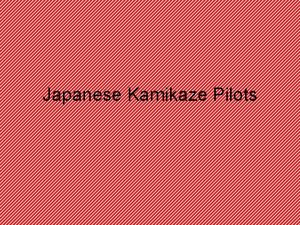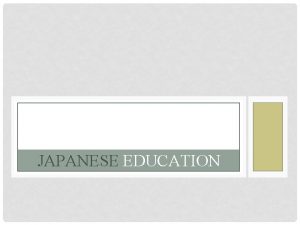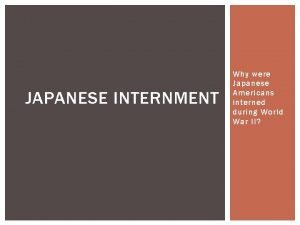1 NEW REGULATORY REQUIREMENTS FOR JAPANESE COMMERCIAL POWER




































































- Slides: 68

1 NEW REGULATORY REQUIREMENTS FOR JAPANESE COMMERCIAL POWER REACTOR FOCUSED ON SEISMIC DESIGN FOR RESTART NPP 第 31回台日 程技術検討会核能検討会 山崎 達広 原子力安全推進協会 Tatsuhiro Yamazaki Japan Nuclear Safety Institute (JANSI)

2 JAPANESE NUCLEAR SITUATION AFTER FUKUSHIMA ACCIDENT

3 Current status of nuclear power in Japan ○ Nuclear power reactors in Japan decreased from 54 to 43 units after the Fukushima Daiichi NPS accident. Tomari ➊➋➌ Kashiwazaki-Kariwa ①②③④⑤➏➐ Shika ①➋ Higashidori ➊ Tsuruga ➊② Legend: ● Plant applying for approval of restart of operation ● Plant under decommissioning ○ Plant whose future policy has not been decided Mihama ➊➋➌ Onagawa ①➋③ Ohi ①②➌➍ Fukushima Daiichi ➊➋➌➍➎➏ Fukushima Daini ①②③④ Takahama ➊➋➌➍ Shimane ➊➋ Tokai Daini ● Hamaoka ➌➍⑤ Ikata ①②➌ Sendai ➊➋ Genkai ➊②➌➍ Breakdown of 54 units: Plant applying for approval of restart of operation: 24 units Plant under decommissioning: 11 units Plant whose future policy has not been decided: 19 units (As of the end of August 2015)

4 Number of units in operation No. of units in operation Fukushima Dai-ichi Accident New Standards enacted 2013. 7. 8 Sendai-1 restarted Ohi-3&4 operated 2011 2012 2013 2014 2015

5 Change in Composition of Power Sources ○Currently, all nuclear power plants are shut down except Sendai-1. About 90% of the generated energy relies on thermal power generation. Composition of electric power generation Coal oil, etc. Nuclear Hydro Renewables (except hydro) Pre-earthquake (FY 2010) Increasing reliance on fossil fuels Post-earthquake (FY 2013) Increase in costs for fossil fuel 3. 6 trillion/year ↓ 7. 7 trillion/year Rate rise (Electric light) 20. 4/k. Wh ↓ 24. 3/k. Wh increase in CO 2 emissions 374 million t-CO 2/year ↓ 484 million t-CO 2/year NB: Red figures in brackets show a comparison between FY 2010 and FY 2013

6 Status of Restart Operation at Nuclear Power Plants Sendai 1 Sendai 2 Takahama 3 Takahama 4 Ikata 3 Ohi 3, 4 Genkai 3, 4 Takahama 1, 2 Mihama 3 Tomari 1, 2, 3 BWR plant Ohi 1, 2 Restart of operation Preparation for start-up Permission Preoperational inspection Permission (End of reviews ③) ③ Review of application for approval of technical specifications (End of reviews ②) ② Review of construction plan approval application Local consent procedure Permission (End of review ①) Deliberations on plant facilities Public comments Deliberation on earthquakes & tsunamis [Design-basis earthquake ground motion] Creation of draft review report Licensing application from the operator Preparing the licensing application ① Examination of application for permission for change in reactor installation license

7 Energy Policy after the Great East Japan Earthquake Outline of the Strategic Energy Plan (related to nuclear power) 【April 2014】 ○Nuclear power is important base load power source -Minimize dependency on nuclear power generation○Promote the restart of operation of the nuclear power plants which satisfy the new regulatory standards ○Continue to promote the nuclear fuel cycle including reprocessing and use of MOX fuel Cost estimation (2014 model plant)【April 2015】 (Yen/k. Wh) 30. 6~ 43. 4 40. 0 35. 0 Policy related cost 30. 0 25. 0 21. 9 20. 0 15. 0 12. 3 10. 1~ Accidental risk cost 24. 3 CO 2 13. 7 Fuel Operation & maintenance 10. 0 Additional safety measures cost 5. 0 Capital 0. 0 Nuclear Oil Coal LNG Wind(onshore) Solar(mega) Decision on Energy Best Mix 【July 2015】 ○Power supply composition in 2030 (approximate) Nuclear Oil Coal LNG Renewable 20~ 22% 3% 26% 27% 22~ 24%

8 Review condition of confirmatory of new regulation (PWR) Utility Unit Hokkaido Tomari #1, 2 2 Loop 579 2013. 7 Tomari #3 3 Loop 912 2013. 7 Mihama #3 3 Loop 826 2015. 3 Takahama #1, 2 3 Loop 826 2015. 3 Takahama #3, 4 3 Loop 870 2013. 7/2015. 2. 12 permitted Ohi #3, 4 4 Loop 1180 2013. 7 Shikoku Ikata #3 3 Loop 890 2013. 7/2015. 7. 15 permitted Kyushu Sendai #1, 2 3 Loop 890 2013. 7/2014. 9. 10 permitted Gennkai #3, 4 4 Loop 1180 2013. 7 Kansai Type Out put (Mw) Sendai #1 2015. 9. 10 commercial operation started Sendai#2 2015. 10. 15 restart, 11 second term commercial operation application

9 Review condition of confirmatory of new regulation (BWR) Utility Unit Type Out put (Mw) application Tohoku Higashidori #1 BWR 5 1100 2014. 6 Onagawa #2 BWR 5 825 2013. 12 Tokyo Kashiwazaki #6, 7 ABWR 1356 2013. 9 Chubu Hamaoka #3 BWR 5 1100 2015. 6 Hamaoka #4 BWR 5 1137 2014. 2 Hokuriku Shika #2 ABWR 1358 2014. 8 Chugoku Shimane #2 BWR 5 820 2013. 12 JAPC Tokai #2 BWR 5 1100 2014. 5 Dengenkaihat su Ooma ABWR 1383 2014. 12

10 Point out from various Fukushima investigation reports • Problems of the previous safety regulations before the Fukushima accident • Severe accident measures are not subject to regulation • There are not Legal mechanism to apply retroactively of the new standard to the existing nuclear power plant (Back fit rule) • It have not sought the highest standard of safety Ø Severe accident measures caused by external events were not considered with a careful consideration, it had been left to the autonomy of utilities Ø There was no legal mechanism of back fit Ø Actively introducing the knowledge of overseas, it had been lack the activities to introducing overseas knowledge to improve the safety for the uncertain risk Ø In addition to the safety assessment for the Earthquake and tsunami, fire, volcano and landslide to be caused an accident, a comprehensive risk assessment to external events had not been done Ø It is desirable to be a centralized legal system

11 NEW NUCLEAR REGULATION AUTHORITY

12 Reform the Nuclear Regulatory Organization üNuclear Regulatory Commission Establishment Act ü It will eliminate the adverse effect of vertically divided administration involved in policy on the development research, and utilization of Reactor technology ü To solve the problem of the fact that one administrative organization of the government have the responsible for both of the functions of the promotion and regulation of the use of nuclear energy ü Always assuming the occurrence of accidents in the use of nuclear energy, the organization provided for the effort to the prevention of it

13 Reform the Nuclear Regulatory Organization ØIndependence • Separate the function for nuclear regulation and nuclear promotion • The Nuclear Regulation Authority (NRA) as an independent commission body ØIntegration • Integrate nuclear regulation functions regarding safety, security, safeguards, radiation monitoring and radioisotopes regulation into the NRA

14 From NRA pamphlet

15 NEW REGULATION

16 Amendments for new Nuclear Regulation Act (promulgated in June 2012) ØNew regulation on sever accidents ØLegally required measures to prevent and mitigate sever accidents ØImprove the safety of nuclear facilities by utility, legally required implementing a comprehensive safety assessment periodically. Report it results to the NRA, and obligated to disclose. ØRegulation: based on the state-of-the–art information Ødevelop the new regulatory standard based on the state of the art information and apply it to existing nuclear facilities introduction of Back-fit rule Ø 40 -years operational limit for NPPs ØLegally define the limit to 40 years ØNRA can permit a less than 20 years extension

17 Newly proposed regulatory requirements for Light water Nuclear power Plants ü Strengthening of Design Basis ü Sever Accident Measures ü Enhanced Measures for Earthquake and Tsunami

18 Policy of new requirements üAdopted Defense-in Depth concept ü Prepare multi layered protective measures üEliminate common cause failures ü Strength fire protection and measures against inundation ü Reinforce SSDs important to safety üAssess and enhance protective measures against extreme natural hazards ü Introduce accurate approached in assessment of earthquake and Tsunami ü Introduce measures against Tsunami inundation ü Shift “redundancy” to “diversity” and “independence” üPerformance demand in regulation ü Concrete measures are depend on Utilities

19 Defence in Depth (INSAG-10) Objective Essential means Level 1 Prevention of abnormal operation and failures Conservative design and high quality in construction and operation Level 2 Control of abnormal operation and Control, limiting and protection detection of failures systems and other surveillance features Level 3 Control of accidents within the design basis Level 4 Control of severe plant conditions, Complementary measures including prevention of accident and accident management progression and mitigation of consequences of severe accidents Level 5 Mitigation of radiological consequences of significant releases of radioactive materials Engineered safety features and accident procedures Off-site emergency response Consider in design up to Level 4 DID Levels

20 Against severe accident and terrorism üPrepare multi layered protection for “prevention of core damage”, “maintain containment integrity”, “controlled release by venting” and “suppression of radioactive materials dispersion” üUse mobile equipment and enhance reliability with permanent system and equipment üEnhance protective measures for spent fuel pool ü Water level instrument, alternative water supply, spray üImprove command structure and instrumentation ü Reinforced seismic-resistance (seismic isolation) of on-site emergency response center ü Improve reliability/durability of communication systems üIntroduce “special safety facility” against intentional air craft attack

21 New regulation Design basis facilities Nuclear facilities need for abnormal transients during operation or prevention of the occurrence of a design basis accident and prevention of expansion Sever accident management facilities Facility having a function to deal with a event of leading to serious accidents or serious accident special safety facility

22 Fukushima Daiichi accident sequence Rx. Scram, Loss of external power Emergency D/G started(14: 47) Design base EQ. Occurred (day 3. 11, 14: 46) Design for Withstand EQ(JEAC 4601 etc. ) ・seismic design ・seismic robust construction etc. Design for withstand Tsunami(Tsunami. JEAC 4629 & IAEA SR) ・sea wall ・watertight door etc. Tsunami invaded(15: 27, 15: 35) Secure alternative power Emergency D/Gs, electric facilities failed、ultimate heat sink lost ・gas turbine generator, AC power vehicle, 、DC power vehicle Emergency response facility Loss of AC power in long term Secure heat removable facilities ・sea water line, air fin cooler Uncovered fuel, melt down start Outbreak Hydrogen、1, 3, 4 Rx, exploded Radioactive material released Severe accident Loss of DC power & control air Secure reactor water injection facilities Mobile reactor injection facilities Enhanced Severe accident instrument systems CV failure prevention facilities ・alternative CV spray systems ・lower pedestal injection system CV filtered ventilation system, water spray gun Prevention

23 Comparison between previous and New regulatory requirements The new regulatory requirements tighten measures to prevent or deal with severs accidents and terrorism Measure to suppress radioactive materials release Design basis to prevent sever accidents : single failure would not lead to core damage Measure to prevent CV failure Measure to prevent core damage - Postulated multiple failures- Consideration of internal flooding Consideration for Fire Reliability of power supply Seismic /Tsunami resistance Enhanced reliability of power supply Consideration for Fire Reinforced Seismic /Tsunami resistance Reinforced items Consideration natural phenomena - Volcanic eruption, tornadoes, forest fires Consideration of natural phenomena SA measures New items Response to intentional aircraft crashes

24 Strength of design basis 1. Comprehensive consideration of natural hazards ① Volcano ② Tornado ③ Forest fire ④ Earthquake ⑤ Tsunami 2. Reinforcement of fire protection measures 3. Enhanced reliability of SSCs important to safety 4. Reinforcement of off-site power supply (connection to different substation through multiple line) 5. Protection of systems for Ultimate Heat Sink (ex, protection of sea water pumps)

25 Example of strength of Design basis External power existing new 2 line (no requirement for independence) 2 independence line In-house Emergency D/G AC power DC power 1 system With 30 min capacity Add. One emergency D/G+ mobile power vehicle Fuel storage 7 days 24 capacity +portable +permanent Reinforcement of off site power supply Substation Substation Nuclear power station

26 Enhancement Tsunami protection and inundation measures Multiplex of Tsunami protection Design tsunami defined with enough margin to historical tsunami and analytical from fault in ocean Example of levee at Hamaoka NPP Water tight door

27 Clarify the criteria for displacement or deformation of the ground of NPP • Buildings and structures of seismic design S class will be placed in the ground there is no outcrop of active faults it is difficult to predict the fault displacement and size, and the magnitude of the force that the ground pushes up the safety related facilities Fault

28 Fault fracture zone check in NPP site • NISA order utilities to re-evaluate for fault fracture zone of the power plant site as part of the seismic back check after the Fukushima accident • At Tsuruga NPP of JAPC, Ohi, Takahama, Mihama NPP of Kansai. EPCo, Shika NPP Hokuriku EPCo and Higashidori NPP of Tohoku EPCo, utilities has examined additional research of fault fracture zone NPP Re-evaluate result Ohi Kansai EPCo Not active fault Mihama Kansai EPCo Not active fault Tsuruga JAPC Fault should be consider in seismic design Shika Hokuriku EPCo Can not deny the movement after the late Pleistocene Higashidori Tohoku EPCo Under review

29 Example of fault fracture zone at Tsuruga and Shika Tsuruga NPP Shika NPP

30 Required, more precise investigation to create the design basis earthquake ground motion (Ss) • More stringent criteria for active fault • Active faults with activities later than Late Pleistocene (later than 120, 000 - 130, 000 years ago) shall be considered for seismic design • Activities in the Middle Pleistocene (later than 400, 000 years ago) be further investigate if needed • More precise methods to define design basis seismic ground motion • 3 D observation of underground structure of the site

31 SEVER ACCIDENT COUNTERMEASURES

32 Prevention of Core Damage • Requirement for measures to prevent core damage assuming beyond design-basis accidents • Beyond-DBAa including the follow events ① ② ③ ④ ⑤ ⑥ ⑦ ATWS Loss of reactor cooling function (at core high pressure) Loss of reactor depressurization function Loss of reactor cooling function (at core low pressure) Loss of UHS System Loss of support function as make up water, power supply Others IPE (Individual Plant Examination by PRA) and IPEEE (Individual Plant Examination for External Events by PRA)

33 Examples of measures against core damage • Loss of UHS system alternative UHS System • Loss of support function SBO alternative onsite AC power

34 Prevention of Containment Failure • Requirements for measures to prevent containment failure after core damage ① ② ③ ④ ⑤ Cooling and depressurization of CV, reduction of release of radioactive materials (e. g. , CV spray) Heat removal from CV and depressurization of CV (e. g. , filter venting) Cooling of molten core at the bottom of CV and inside RPV (e. g. , water injection) Prevention of direct containment vessel heating (e. g. , depressurization of RPV) Prevention of Hydrogen explosion inside CV

35 Example of measures against CV failure (BWR) ① CV spray to cool and depressurize CV and reduce release of radioactive materials ② Filtered venting to reduce the pressure and temperature inside CV in addition to reducing radioactive materials while exhausting ③ Water injection system in to lower part of CV to prevent CV failure due to molten core

36 Example of SA facilities in Hamaoka NPP (BWR) PCV failure preventing facilities ① water injection line to reactor well ② alternate PCV spray ③ injection line to PCV lower part PCV filter venting facility

37 Measures against intentional aircraft attack, etc. • Require “Specialized Safety Facilities” to mitigate release of radioactive materials after core damage due to intentional aircraft attack・・・・allow 5 years to install

38 REVIEW RESULT OF SENDAI NPP

39 Review result of Sendai NPP-1 • Requirement: 1. evaluate the characteristics of ground motion amplification 2. evaluate the stability of the ground • Abstract of application Ø the geology of the basement of the peripheral power plant Ø Survey the share velocity of seismic waves traveling through the underground Ø Set the earthquake amplification model of the ground Ø Investigation of the possibility fault of the peripheral site Ø Investigation of the displacement of the ground when the estimate earthquake activate • Review result by regulator ① Not unusual amplification of earthquake in the ground ② ground subsidence is not large, and will not be inclined by the earthquake ③ Confirmation that the fault of the underground will not displace

40 Review result of Sendai NPP-2 • Requirement design the safety related facilities withstand the seismic force by using follow 2 type of design earthquake Ø to identify the epicenter of fault by the investigation, and estimate the earthquake which will be a significant impact on the site Ø to collect observation records of past earthquakes which the epicenter have not be identified Abstract of application Ø Ground motion developed by identified epicenter is 540 gal, original one is 372 gal Ø Ground motion from unidentified epicenter is 620 gal Review result Ø Design ground motion has been formulated in light of the latest scientific knowledge

41 Counter measure for Tornado • Requirement • Estimate max. tornado consider the site characteristic • Reactor facilities shall maintain the structural safety against estimated tornado load (wind pressure, collision load by the missile ) • Abstract of application Ø it was assumed a 75. 4 m/s tornado that might occur once of 100, 000 years Ø On the basis of this estimation, estimated 100 m/s tornado for design the protection net and set the measure for scattering prevention

42 Public comments for Sendai NPP construction permit review result-1 1. how reflect to the review the lessons learned from the Fukushima accident ü It was established a new standard in light of the lessons of Fukushima accident ü as consider the event of common mode failure of safety function by the earthquake and tsunami, the regulation was significantly raised the assumed measures of natural phenomena including the earthquake and tsunami ü We were not able to stop the progress of the accident. Based on this, in addition to the prevention of accidents, the newly requested measures for mitigation of expansion and preventing the accident ü New regulatory standards will be applied to a existing nuclear reactor

43 Public comments for Sendai NPP construction permit review result-2 2. It does not said the world’s highest level regulation, not to determine the cause of the Fukushima accident ü The main reason of the Fukushima accident has identified ü New regulatory standards were created to reflect the knowledge of these finding fact and the world safety insight

44 Public comments for Sendai NPP construction permit review result-3 3. Is it right to assume that it does not occur more thing that utility is currently assumed Unexpected natural phenomena occur frequently. Is it considered that the unexpected natural phenomena will not to occur at the nuclear power plant ü At Fukushima NPP, the assumed height of the tsunami was insufficient. So, based on this reflection, new regulatory guide required the utilities to assume more stringent about the natural phenomena that affect the safety function of the nuclear power plant

45 Public comments for Sendai NPP construction permit review result-4 4. Is the securing of electric power prepared thoroughly against natural phenomena Can the electric power be used at the time of harsh natural environment and accidents condition ü In Fukushima NPP, it was not able to obtain the power from the outside under the influence of the earthquake ü Although the emergency power generator supplied required power to the plant, all of the power has been lost by the tsunami ü Under the new regulatory standards, in the light of this lesson, it imposed a strengthening of electric power source

46 Public comments for Sendai NPP construction permit review result-5 5. Are counter-measures for terrorism put into effect sufficiently? ü The new regulations and standards are also considered damage caused by intensive large aircraft collision and other terrorism, regulatory body asked to develop management systems of reducing radioactive material emission ü In Sendai NPP, emergency response personnel of the power plant have being distributed to more than one meeting place and outside the power plant. Utility create the procedure of fire extinction by foam fire extinction cannon, assuming a large fire caused by the intensive large aircraft collision and aircraft fuel ü it has established a procedure when the operation can not be monitored in the central control room ü In addition, such as generator vehicle and fire extinguisher cannons have been dispersed so that these are not damaged at the same time

47 COUNTERMEASURES FOR SEVERE ACCIDENT

48

Prevention for core damage 49

Counter measures for PCV failure 50

51 SEISMIC DESIGN FOR SEVER ACCIDENT MANAGEMENT FACILITIES (JAE ACTIVITY)

52 Classification of SA management facilities Prevention Mitigation Name function Permanent installed seismic S class SA facilities Alternate the function of seismic S class design based accident management facilities (RPV, SFP, PCV, emergency power supply etc. ) ・reactor injection ・secure power supply ・heat removable from reactor core Permanent installed SA facilities Alternate for the function of low seismic class design based accident management facilities (B, C class) (PCV instrument systems, intake structure etc. ) Permanent installed SA mitigation facilities (seismic S class ) Mitigate the outbreak of SA or the impact of SA (RPV, SFP, PCV, emergency power supply, intake structure, emergency response facilities etc. ) ・cooling the PCV ・reactor well injection ・filtered ventilation from PCV etc. Portable SA management facilities Power supply vehicle, potable injection pomp, heat removal air fin cooler etc. Name Function Specified SA management facilities In the case of the core damage by intentional aircraft collision or terrorist, inhibit abnormal release of radioactive material by the containment failure ・Cooling meltdown core ・Heat removal, depressurize and eliminate radioactive materials from PCV etc.

53 Combination of Plant conditions and External hazard Operational states NO AOO Accident conditions DBAs Design Extension Conditions Estimate EQ. on plant conditions Conditions generated by External Hazard (Earthquake) Conditions practically eliminates Beyond design basis • DEC was defined as a state of the plant that have been brought by the multiple failures of safety systems, external hazard (earthquake, tsunami, such as aircraft fall) was defined irrespectively the state of plant conditions. • For consider the combination of the plant condition and earthquake, we consider the design earthquake on the assumption of plant condition. • And in the design procedure, we should confirm the plant condition does not change by the earthquake. • for Design extension earthquake, core damage and large early release of radioactive materials should be evaluated by the PSA method rather than considering the combination of the plant state and external hazard.

54 Plant condition of IAEA and Operating condition of JEAG (connecting to allowable stress) Operational states NO AOO Accident conditions DBAs Design Extension Conditions No core melt Severe Accident(Core melt) Conditions generated by External & Internal Hazards Operating I Operating II, III Operating IV Meaning to define the operating conditions V in JEAC In the state of SA, the design pressure, temperature, etc. are severe than operating condition IV. In the condition of SA, we have to prevent the core damage and if the condition move to core damage, it is necessary to ensure the containment function. So, we consider the combination with SA load and seismic load as the external load for the design of SA facilities. Here, a more rational and realistic assessment are required to perform the required function. Specifically, it is considered to check the containment function with the oriented certain plastic deformation design. So, the operating condition V is considered in JEAC. Conditions practically eliminates Beyond design basis Operating V To prevent a sudden deviation (Cliff edge) from the plant condition VI and V, it is ensured a sufficient margin for the facilities using in each plant conditions.

55 Relation between safety measures and evaluation criteria in EQ. Safety measures ・Seismic robust measures ・Tusnami countermeasure (dry site) DBA ・other external hazards (tornado, volcano etc. ) Criteria in EQ. facilities seismic classification ・S class ・B class ・C class Code & standard allowable stress CAS JEAC 4601 allowable stress DAS ・core damage prevention measures ・containment vessel failure SA prevention measures ・large early release of radioactive material pretension measures classification of SA facilities allowable limit EAS ・SA prevention facilities JEAGXXXX- ・SA mitigation facilities even more realistic criteria ・Specified SA management 210 X should be accepted facilities

Design requirements for the external hazard • • • Safety function is not impaired by the design EQ. Safety function is not impair by the design tsunami The safety function is not compromised by the envisaged external hazard. 56 Design so that accident does not occurred by the envisaged external hazard If, the accident occurred, it make sure to prevent the spread of accidents and the mitigation measures are established even in the envisaged external hazard Combination of plant condition and earthquake Consider the frequency of occurrence, duration of accident condition and combine the EQ. frequency. Applied the screening criteria 10 -7/RY Normal OP. ・normal OP. ・outage ・test ・standby Estimate DBA ・LOCA ・MS line break ・CR drop (BWR) etc. Estimate SA ・Station Black out ・loss of ultimate heat removals ・reactor injection function loss in LOCA etc. 【make sure that earthquake does not lead to the design basis accident 】 combine the load and earthquake during normal operation. Make sure it does not lead to design basis accident in the earthquake caused. Estimated EQ. in normal operation 【also assumed the design basis accident has occurred】 Design basis accident is treated as an independent event of an earthquake, combine the accident and earthquake. Make sure the accident not to progress by the earthquake. Estimate EQ. after the DBA with screening criteria JEAC 4601 (prevention) 【assumed SA occurred】 SA is treated as the independent event of earthquake, combine the accident and earthquake Estimated SA JEAGXXXX (Prevention & Mitigation)

57 Combination of seismic load and accident load Screening value 10 -7/R. Y SA probability Seismic probability*2 Lapse time for combination Sd 10 -2/Y 10 -1 Y over Ss 5× 10 -4/Y 1 Y over*3 10 -4/R. Y

58 Facilities Operating SA condition, condition +EQ. short term SA condition, long term SA mitigation facilities Permanent installed S class Stand by condition + Ss Operating condition V (SA) + Ss SA long term load + seismic load To determine the combined seismic load, consider SA frequency, pressure & temp duration and EQ. frequency Ex. Ss: 5× 10 -4/year Sd: 10 -2/year Screening criteria 10 -7/reactor year Not to consider Ss load because of screening criteria (Specified SA management facilities) Portable SA facilities Consider temp. , pressure, active load , environmental condition under the SA Stand by condition + Ss Confirm function maintaining This equipment is installed for a variety of permanent equipment. Consider the distributed layout for deployment. In addition, this equipment deploy in the area of not to affected the SA load so, we should not consider SA load for the design of this portable facilities

59 SA counter measure availability evaluation 1 st Step: without consider SA facilities Core damage probability Internal events Accident sequence External events CV damage probability 2 nd Step: selected accident sequence with SA facilities ü Evaluate the availability of SA facilities Ø For prevent core damage Ø For prevent CV damage Ø For prevent spent fuel damage in SFP Ø For prevent fuel damage in reactor core during outage ü Evaluated results make sure the evaluation items

60 Plant feature from PRA result (example) PRA Plant feature without SA facilities SA counter measures Internal event (operation) Core damage probability dominant on loss of RHR, Loss of total AC power p Gus turbine generator p PCV filtered ventilation system External Core damage probability dominant on event loss of power (earthquake) Ex. Loss of total AC power by EQ and loss of emergency D/G induced core damage without ECCS p Gus turbine generator p PCV filtered ventilation system External event (Tsunami) p Inundation protection of reactor building and secure core injection function p Core cooling by the Emergency sea water pump All core injection function failure because of Tsunami inundation

61 Prevention of core damage (example) Function loss Gr. Accident sequence Main SA facilities Results (evaluation items) Hi+Lo core injection failure Loss of feed water + Hi + Lo core injection Alternate HPCS Alternate LPCI CV spray CV filter ventilation Loss of total AC power Loss of external AC power + Loss of D/G RCIC Emergency gas turbine generators Alternate LPCI Emergency sea water pump DC power CV alternate spray system Etc. Loss of SCRAM MSIV failure close + Loss of SCRAM Alternative CR insertion system Recirculation pump trip system SLC system Fuel clad temp < 1200℃ Oxidized clad < 15% of clad thickness Pressure boundary pressure < 1. 2* design pressure CV pressure < design or tolerated pressure CV temp < Design temp or tolerated temp

62 Prevention of CV damage (example) CV damage mode Accident sequence Main SA facilities Results (evaluation items) Static load of CV pressure/ temp (CV damage by over pressure / temp) LOCA + loss of HPCI + LPCI Alternate CV spray Reactor well injection CV filter ventilation Emergency gas turbine generators CV pressure and temp < limitted pressure and temp CV direct heating Feed water loss + HPCI by fused material + loss of RPV depress by relief/ safety valve RPV depress under ** Mpa H 2 detonation Inert gas atmosphere O 2 density under in CV 5% (prevent H 2 Feed water loss + HPCI +LPCI Evaluate total release of Cs detonation)

63 THANK YOU FOR YOUR ATTENTION

64 Plant conditions and Design basis (IAEA SSR 2/1 TECDOC Draft) JEAG design basis NO: Normal Operation AOO: Anticipated Operational Occurrences DBA: Design Basis Accidents DEC : Design Extension Conditions

65 Combination of SA facilities and seismic load Facilities Operating SA condition, condition +EQ. short term Operating condition SA prevention facilities Permanent I, III, IV+Ss installed seismic S class SA facilities SA prevention facilities are equipment for preventing the occurrence of SA, so the plant Operating condition is not to SA prevention facilities Permanent I, III, IV+B, C class progress to the SA condition. So, SA EQ. installed SA load may not be facilities considered SA condition, long term

66 Meaning to define the operating conditions V in JEAG ü In the state of SA, the design pressure, temperature, etc. are severe than operating condition IV. ü In the condition of SA(a), we have to prevent the core damage and if the condition will move to core damage. ü In the condition of SA(b), we have to mitigate the outbreak of the impact of SA. ü It is necessary to ensure the containment function and each prevention and mitigation function. ü So, we consider the combination with SA load and seismic load as the external load for the design of SA facilities. ü Here, a more rational and realistic assessment are required to perform the required function. Specifically, it is considered to check the containment function with the oriented certain plastic deformation design. So, the operating condition V is considered in JEAC.

67 Combination of operating condition and EQ. in JEAC *: using performance goals 1. 0 × 10 -4 / reactor year of CDF and combined with EQ. frequency

68 New regulation in Japan after Fukushima accident • in case the SA has occurred, regulation request measures to stem the progress of SA • Prevent core damage • Maintain CV function • Controlled radiological release by ventilation system from CV • Combined portable facilities and permanent facilities for Sever accident management
 Commercial and noncommercial food service operations
Commercial and noncommercial food service operations Power triangle formula
Power triangle formula Commercial power supplies
Commercial power supplies Japanese new wave
Japanese new wave Formuö
Formuö Typiska novell drag
Typiska novell drag Nationell inriktning för artificiell intelligens
Nationell inriktning för artificiell intelligens Returpilarna
Returpilarna Shingelfrisyren
Shingelfrisyren En lathund för arbete med kontinuitetshantering
En lathund för arbete med kontinuitetshantering Personalliggare bygg undantag
Personalliggare bygg undantag Tidbok yrkesförare
Tidbok yrkesförare Anatomi organ reproduksi
Anatomi organ reproduksi Densitet vatten
Densitet vatten Datorkunskap för nybörjare
Datorkunskap för nybörjare Stig kerman
Stig kerman Debatt artikel mall
Debatt artikel mall Delegerande ledarstil
Delegerande ledarstil Nyckelkompetenser för livslångt lärande
Nyckelkompetenser för livslångt lärande Påbyggnader för flakfordon
Påbyggnader för flakfordon Lufttryck formel
Lufttryck formel Publik sektor
Publik sektor Jag har gått inunder stjärnor text
Jag har gått inunder stjärnor text Presentera för publik crossboss
Presentera för publik crossboss Argument för teckenspråk som minoritetsspråk
Argument för teckenspråk som minoritetsspråk Bat mitza
Bat mitza Klassificeringsstruktur för kommunala verksamheter
Klassificeringsstruktur för kommunala verksamheter Epiteltyper
Epiteltyper Claes martinsson
Claes martinsson Centrum för kunskap och säkerhet
Centrum för kunskap och säkerhet Verifikationsplan
Verifikationsplan Mat för unga idrottare
Mat för unga idrottare Verktyg för automatisering av utbetalningar
Verktyg för automatisering av utbetalningar Rutin för avvikelsehantering
Rutin för avvikelsehantering Smärtskolan kunskap för livet
Smärtskolan kunskap för livet Ministerstyre för och nackdelar
Ministerstyre för och nackdelar Tack för att ni har lyssnat
Tack för att ni har lyssnat Hur ser ett referat ut
Hur ser ett referat ut Redogör för vad psykologi är
Redogör för vad psykologi är Borstål, egenskaper
Borstål, egenskaper Atmosfr
Atmosfr Borra hål för knoppar
Borra hål för knoppar Orubbliga rättigheter
Orubbliga rättigheter Stickprovsvarians
Stickprovsvarians Tack för att ni har lyssnat
Tack för att ni har lyssnat Rita perspektiv
Rita perspektiv Verksamhetsanalys exempel
Verksamhetsanalys exempel Tobinskatten för och nackdelar
Tobinskatten för och nackdelar Toppslätskivling dos
Toppslätskivling dos Handledning reflektionsmodellen
Handledning reflektionsmodellen Egg för emanuel
Egg för emanuel Elektronik för barn
Elektronik för barn Mantel som bars av kvinnor i antikens rom
Mantel som bars av kvinnor i antikens rom Strategi för svensk viltförvaltning
Strategi för svensk viltförvaltning Kung dog 1611
Kung dog 1611 Humanitr
Humanitr Romarriket tidslinje
Romarriket tidslinje Tack för att ni lyssnade
Tack för att ni lyssnade Matte större än tecken
Matte större än tecken Dikt med fri form
Dikt med fri form Inköpsprocessen steg för steg
Inköpsprocessen steg för steg Fuktmätningar i betong enlig rbk
Fuktmätningar i betong enlig rbk Ledarskapsteorier
Ledarskapsteorier Vad är hsil
Vad är hsil Myndigheten för delaktighet
Myndigheten för delaktighet Trög för kemist
Trög för kemist Sju principer för tillitsbaserad styrning
Sju principer för tillitsbaserad styrning Läkarutlåtande för livränta
Läkarutlåtande för livränta Tät skog karttecken
Tät skog karttecken


